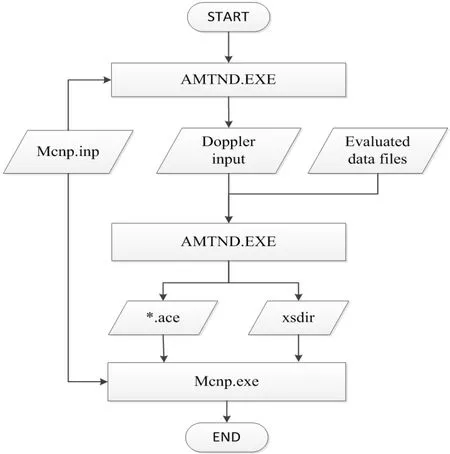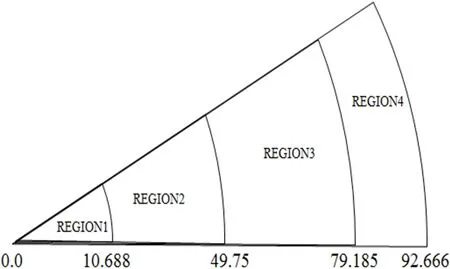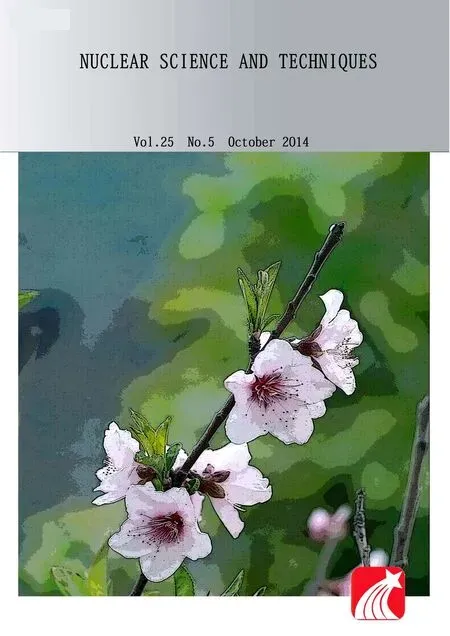Development and testing of the code for automatic generating of multi-temperature continuous-energy neutron cross section libraries?
CHEN Chong(陳沖),ZOU Jun(鄒俊),ZHENG Jian(鄭劍),SUN Meng-Ping(孫夢萍),and CHEN Hong-Li(陳紅麗)
1School of Nuclear Science and Technology,University of Science and Technology of China,Hefei 230027,China
2Institute of Nuclear Energy Safety Technology,Chinese Academy of Sciences,Hefei 230031,China
Development and testing of the code for automatic generating of multi-temperature continuous-energy neutron cross section libraries?
CHEN Chong(陳沖),1,?ZOU Jun(鄒俊),2ZHENG Jian(鄭劍),2SUN Meng-Ping(孫夢萍),1,2and CHEN Hong-Li(陳紅麗)1
1School of Nuclear Science and Technology,University of Science and Technology of China,Hefei 230027,China
2Institute of Nuclear Energy Safety Technology,Chinese Academy of Sciences,Hefei 230031,China
In the nuclear reactor design,a code for automatically generated multi-temperature continuous-energy neutron cross section data library,which is called AMTND for short,was designed and developed to meet the need of the reactor core design coupled with thermal-hydraulic design.The code can provide a point-wise crosssection at any temperature for a Monte Carlo neutron transport program,such as MCNP.In ensuring that the nuclear data produced by AMTND meets the testing of critical benchmark experiments,the time-consumed by the nuclear data generating of AMTND compared with NJOY’s was carried out and the result shows the code’s excellence.In order to test the accuracy of the code,the Doppler coefficient test benchmark was also carried out and the results verified the code preliminarily.
Reactor design,Temperature doppler coefficient,Critical benchmark experiments
I.INTRODUCTION
Nuclear data libraries are the basic of neutronic design for reactors.In the core design,various reactor parameters, for example,reactivity coefficients of the reactor transition from a cold state under zero power to a hot state under zero power and to a hot state under full power,needed to be simulated.The core design will also be coupled and iterated mutually with thermal-hydraulic design.In the coupling process, each set of thermal-hydraulic parameters should correspond to a set of reactor design parameters.A variety of nuclear databases for real-time temperature needs to be generated in calculating these parameters of the reactor core.
In this paper,based on reactor design studies at home and abroad and the calculations in the actual operation process, an Automatically generated Multi-Temperature continuousenergy Neutron cross section Data library code,called AMTND for short,was designed and developed.
II.THE DESIGN OF AMTND
A.Background
Using the Monte Carlo neutron transport code(MCNP)is widely recognized as more precise and mature than any other neutron transport program code in reactor design and analysis.The point-wise continuous-energy cross section data in ACE format is suitable for use by the MCNP family of Monte-Carlo codes and other codes that can read the same format library.
When using MCNP to calculate temperature-related parameters in the design of a rector core,nuclear data from corresponding temperatures needed to be produced to ensure its accuracy.That was quite a waste of time.A nuclear data processing package SIGACE[1]was released by IAEA.It could broaden the ACE format data at merely 300K to higher temperatures based on FENDL2.1 nuclear data.But it would produce errors when dealing with some heavy nuclei,such as the fallacious values of the nuclear data’s location parameter JXS array[2].
B.Doppler-broadening
In the neutron calculations,the effective cross section for a material at temperatureTis defined as the cross section that gives the same reaction rate for stationary target nuclei as the real cross section gives for moving nuclei.In many cases of interest,the target motion is isotropic and the distribution of velocities can be described by the Maxwell-Boltzmann function[2].Therefore,the standard form of the Dopplerbroadened cross section is as follows:

where,α=M/(2kT),V=|v?v′|,kis Boltzmann’s constant,Mis the target mass,vis the velocity of the incident particles,v′is the velocity of the target,andσ(T,v)is the cross section for nuclides.
C.The preparation of the MCNP input file
Writing the information for radionuclide species and radionuclide temperatures that needed in the MCNP neutron transport calculations in the MCNP input file without interfering with the normal operation of MCNP.For example:

This is the description of the material card of the MCNP input file.The original MCNP input file is on the left of the character‘$’and the comment is on the right.‘82208’stands for the radionuclide types of elements.The first two digits are for the number of protons and the last three digits are for the mass of the nuclides.‘83c’is for the database identifier.It can be defined according to the user’s own needs.In order to distinguish a normal radionuclide from a transient radionuclide, the transient radionuclide was defaulted to‘*1.c’deliberately.‘t=356.9K’is the nuclides temperature.All of the letters are not case sensitive.
D.The programming of AMTND
This work completes the production of the database library and the neutron transport calculations in the process.The flow chart of AMTND is given in Fig.1.
1.The AMTND reads radionuclide species information, database identifiers,andradionuclide temperature from the material card of the MCNP input file.Meanwhile, AMTND will merge the identical information of all the nuclidesautomaticallyandstoreit inatemporarystructure array.
2.AMTND sealed the radionuclide species information, radionuclide identi fi cation(ID)number,and radionuclide evaluation database name(408 nuclides come from HENL-ADS)in a structure array.Using the radionuclide species information obtained from MCNP input file and the radionuclide ID number,a radionuclide evaluation database name could be found in the structure array above.
3.Using the information on the radionuclide species,radionuclide ID number,database identifiers,and the temperature obtained above,AMTND generated a Doppler-broaden input file automatically.
4.AMTND calls for Doppler-broaden modules.It reads the Doppler input file and the evaluation database files and then generates ACE format files and corresponding index files.
5.Merge the ACE format files and the corresponding index files into the original database.The new database can be used by MCNP.
III.TESTING AND DISCUSSION
The testing of the code was mainly reflected in the accuracy of the data and the time consumed by generating the nuclear data.There are three tests as follows.

Fig.1.The flow chart of AMTND.
A.Critical benchmark experiments
Critical benchmarks testing mainly deals with some thermal and fast reactor data[3–8].In this test,10 fast reactor experiments,which were released by Organization for Economic Cooperation and Development(OECD),were selected from the“International Handbook of Evaluated Criticality Safety Benchmark Experiments”.The evaluations of the radionuclide come from HENDL-ADS[9]and the temperature is 293.6K.
Based on criticality calculations using MCNP with the data produced by AMTND,the overall agreement ofkeffbetween experimentally measured and computed shown in Table 1 was very good.Some of the deviation between the calculation results and the experiment values was less than that produced by NJOY.
B.Time-consumed by generating nuclear data
As it is shown in Table 2,AMTND has been greatly improved by NJOY99 in generating an actinide nuclei data library.The average speedup ratio is 1.37 and the maximum speedup ratio is 1.61.
C.SEFOR Doppler benchmark
The SEFOR reactor[11]was designed to provide a Doppler measurement in an environment that is representative of an operating LMFBR with respect to the neutron spectrum,fuel temperature range,reactor composition,and the fuel microstructure.Standard fuel for SEFOR was mixed oxide(20%PuO2,80%UO2),in which the Pu contained aminimum amount of240Pu(~8%of the Pu)and the U was depleted in235U.A one-dimensional spherical model is analyzed in the present study.The 1-D SEFOR Doppler benchmark spherical model is shown in Fig.2 and the spherical model region composition is shown in Table 3.More details can be found in Ref.[11].Using the Doppler Calculation Model,the isothermal Doppler coefficient is computed as described below:

TABLE 1.The critical test of database produced by NJOY99 and AMTND

TABLE 2.The time consumed by the nuclide data produced by NJOY99 and AMTND in Doppler broadening(s)

Fig.2.1-D SEFOR Doppler benchmark spherical model(in cm).

T1=677K;average fuel temperature at zero power;
T2=1365K;average fuel temperature at 20MW;
k1=neutron multiplication factor with the fuel atT1;

TABLE 3.SEFOR Doppler benchmark,Spherical Model Region composition(atom/barn-cm)

TABLE 4.The calculation results of SEFOR model
k2=neutron multiplication factor with the fuel atT2.
The radionuclide of the SEFOR model adopted is the evaluation documents of HENDL-ADS/MC[9].The results are shown in Table 4.A correction factor for modeling of?0.0005 was obtained due to the resonance heterogeneity,subassembly heterogeneity and other factors[11]. The calculated value of the Doppler coefficients were?0.0081±0.0011 using NJOY-MCNP and?0.0080±0.0012 using AMTND-MCNP.These results compared well with the experimental result of?0.0080±0.0010.
IV.CONCLUSION
In this work,an automatically generated continuousenergy neutron cross section data library code called AMTND was designed and developed.The code was tested by critical benchmark experiments,and was time-consumingfrom generating the nuclear data and the isothermal Doppler coefficient test benchmark.The results preliminarily showed the accuracy and reliability of the code.More verification about the code will be needed in the future.
ACKNOWLEDGMENTS
The authors would like to thank the staffs of the FDS team for giving advice and guidance during the course of research of this paper.
[1]Amit R S,Ganesan S,Trkov A,et al.The SIGACE package for generating high temperature ACE fi les.http://www.nds. iaea.org/fendl21/
[2]Macfarlane R E and Muir D W.NJOY91.91,A code system for producing point-wise and multi-group neutron and photon crosssections fromENDF/Bevaluatednucleardata.NewMexico:LANL,1994.
[3]Frankle S C.Criticality Benchmark Results Using Various MCNP Data Libraries.Los Alamos National Laboratory,Report LA–13627,July 1999.
[4]Mosteller R D,Frankle S C,Young P G.Data testing of ENDF/B-VI with MCNP:critical experiments,thermal-reacter lattices and time-of-flight measurements,advances in nuclear science and technology.1997,24:131–135.
[5]Bowman S M,Jordan W C,Mincey J F,et al.Experience with the SCALE criticality safety cross-section libraries.Oak Ridge National Laboratory,NUREG/GR-6686(ORNL/TM-1999/322),October 2000.
[6]Wright R Q,Jordan W C,Leal L C.Fast and thermal data testing of U-233 critical assemblies.Oak Ridge National Laboratory,1999.
[7]Wright R Q and Leal L C.Fast and thermal data testing of LEU,IEU and HEU critical assemblies.Oak Ridge National Laboratory,1999.
[8]Pelloni S,Grimm P,Mathews D,et al.Validation of LWR calculation methods and JEF-1 based data libraries by TRX and BAPL critical experiments.Paul Scherrer Institut,JEF REPORT-11,Jun.1989.
[9]Chen C,Zou J,Xu D Z,et al.Chinese J Nucl Sci Eng,2012,32:360–365.(in Chinese)
[10]Chadwick M B.Nucl data sheets,2006,107:2931–3059.
[11]Fast Reactor Benchmark No.14.ENDF-202,Cross section evaluation working group benchmark speci fi cations.National Neutron Cross Section Center,BNL,USAEC,Report No. BNL-19302(ENDF-202),Nov.1974.
10.13538/j.1001-8042/nst.25.050602
(Received December 31,2013;accepted in revised form March 25,2014;published online September 20,2014)
?Supported by the National Natural Science Foundation of China(No. 91326101)
?Corresponding author,shchshch@ustc.edu.cn
 Nuclear Science and Techniques2014年5期
Nuclear Science and Techniques2014年5期
- Nuclear Science and Techniques的其它文章
- The effect of Nb additive on Te-induced stress corrosion cracking in Ni alloy:a fi rst-principles calculation?
- Steady thermal hydraulic characteristics of nuclear steam generatorsbased on the drift flux code model?
- A method of estimating and subtracting the hydrogen background in the natural carbon target used in the12C+12C experiment?
- Density functional theory study of H,C and O chemisorption on UN(001)and(111)surfaces?
- The extraction and smoothing algorithms for γ-ray spectrum of a CdZnTe detector system
- Applying image processing method to treat digital signals?
